engine FORD FIESTA 2007 Workshop Manual
[x] Cancel search | Manufacturer: FORD, Model Year: 2007, Model line: FIESTA, Model: FORD FIESTA 2007Pages: 1226, PDF Size: 61.26 MB
Page 783 of 1226
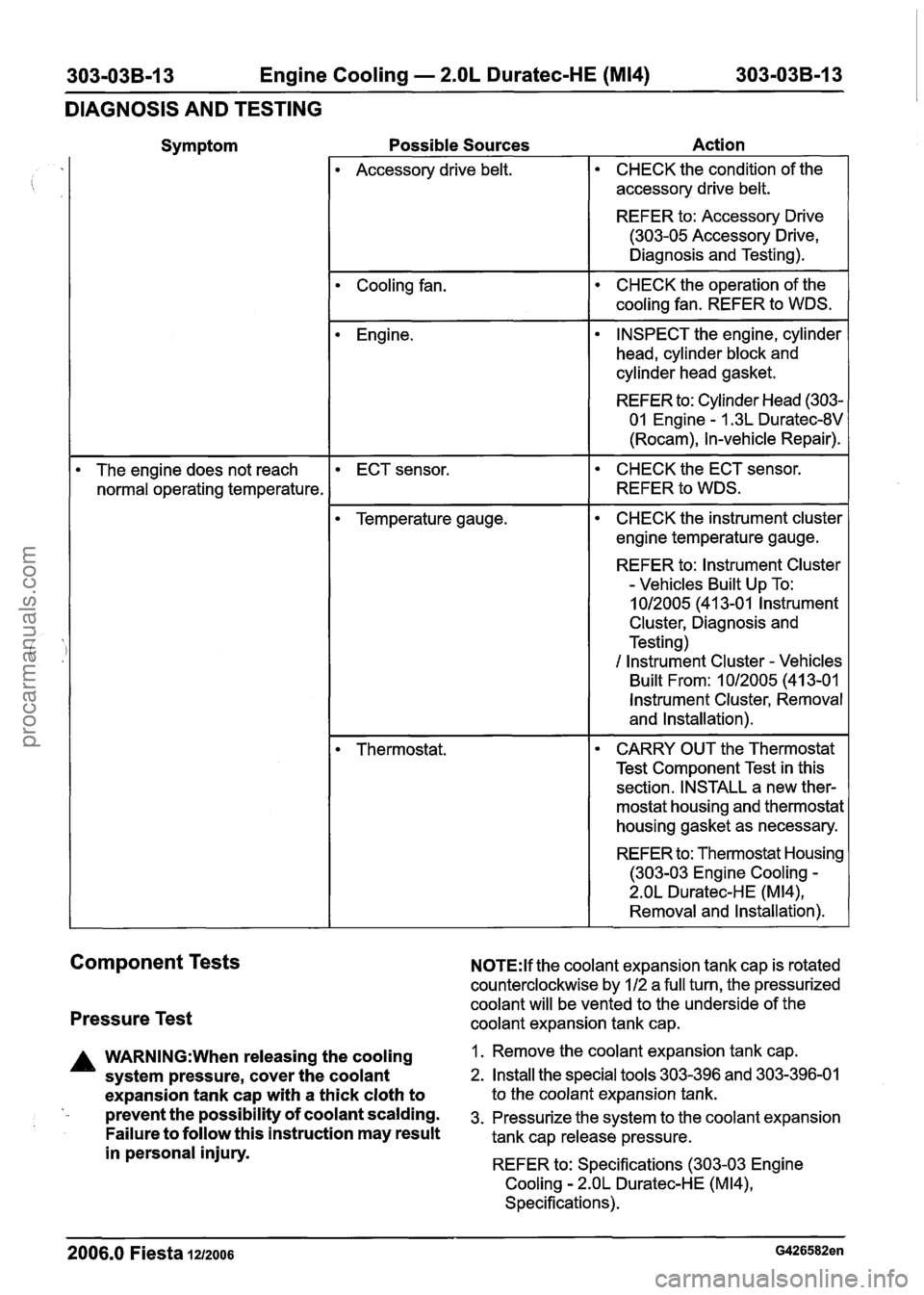
Engine Cooling - 2.OL Duratec-HE (M14)
DIAGNOSIS AND TESTING
Symptom Possible Sources
Action
I Accessory drive belt. CHECK the condition of the
accessory drive belt.
REFER to: Accessory Drive
(303-05 Accessory Drive,
Diagnosis and Testing).
Cooling fan.
CHECK the operation of the
I cooling fan. REFER to WDS.
Engine. INSPECT the engine, cylinder
head, cylinder block and
cylinder head gasket.
REFER to: Cylinder Head
(303-
01 Engine - I .3L Duratec-8V
(Rocam), I n-vehicle Repair).
The engine does not reach
normal operating temperature. CHECK the ECT sensor.
I REFER to WDS.
Temperature gauge. CHECK the instrument cluster
engine temperature gauge.
REFER to: lnstrument Cluster
- Vehicles Built Up To:
1012005 (41 3-01 lnstrument
Cluster, Diagnosis and
Testing)
I lnstrument Cluster - Vehicles
Built From:
1012005 (41 3-01
lnstrument Cluster, Removal
and Installation).
Thermostat. CARRY OUT the Thermostat
Test Component Test in this
section. INSTALL a new ther-
mostat housing and thermostat
housing gasket as necessary.
REFER to: Thermostat Housing (303-03 Engine Cooling
-
2.OL Duratec-HE (M14),
Removal and Installation).
Component Tests
Pressure Test
A WARNING:When releasing the cooling
system pressure, cover the coolant
expansion tank cap with a thick cloth to
- prevent the possibility of coolant scalding.
Failure to follow this instruction may result
in personal injury.
N0TE:lf the coolant expansion tank cap is rotated
counterclockwise by 1 12 a full turn, the pressurized
coolant will be vented to the underside of the
coolant expansion tank cap.
1. Remove the coolant expansion tank cap.
2. Install the special tools 303-396 and 303-396-01
to the coolant expansion tank.
3. Pressurize the system to the coolant expansion
tank cap release pressure.
REFER to: Specifications (303-03 Engine
Cooling
- 2.OL Duratec-HE (M14),
Specifications).
2006.0 Fiesta 1212006 G426582en
procarmanuals.com
Page 784 of 1226

303-03B-14 Engine Cooling - 2.OL Duratec-HE (M14) 303-03B-14
DIAGNOSIS AND TESTING
4. Observe the cooling system pressure tester make sure the pressure test reading
is
gauge reading for approximately two minutes. repeatable
and within acceptable gauge reading
The pressure should not drop during this time. limits of
the coolant expansion tank cap.
( If the system holds Pressure, proceed to Step 5. If the pressure test gauge readings are not 7. If the system does not hold pressure, check
within the acceptable gauge reading limits,
it thoroughly for coolant leaks.
INSTALL a new coolant expansion tank cap.
5. Check the engine for coolant leaks. Drain the
cooling system, repair any coolant leaks found
and fill and bleed the cooling system as
Thermostat Test
necessaw.
REFER to: Cooling System Draining, Filling and
Bleeding (303-03 Engine Cooling
- 2.OL
Duratec-HE (M14), General Procedures).
.Recheck the system by repeating Steps 3 and
4 at least twice.
Radiator Leak Test, Removed From Vehicle
CAUTI0N:Radiator internal pressure must
not exceed
130 kpa (20 psi) or damage may
result.
Clean the radiator thoroughly before leak testing
it, to prevent contamination of the water in the test
tank. Leak test the radiator in clean water with 138
kpa (20 psi) air pressure. Check it thoroughly for
air leaks. INSTALL a new radiator if necessary.
REFER to: Radiator (303-03 Engine Cooling
- 2.OL
Duratec-HE (M14), Removal and Installation).
Coolant Expansion Tank Cap Pressure Test
A WARNING:When releasing the system
pressure, cover the expansion tank cap
with a thick cloth to prevent the possibility
of coolant scalding, Failure to follow this
instruction may result in personal injury.
1. Remove the coolant expansion tank cap.
2. Use water to clean the area of the rubber seal
and pressure relief valve. Install the pressure
tester and adapter and immerse the coolant
-
expansion tank cap in water.
N0TE:lf the plunger of the pump is depressed too
quickly, an erroneous pressure reading will result.
3. Slowly depress the plunger of the pressure test
pump until the pressure gauge reading stops
increasing, and note the highest pressure
reading obtained.
4. Release pressure by turning the pressure relief
screw counterclockwise. Tighten the pressure
relief screw and repeat step 3 at least twice to
I. Connect the WDS to the data link connector
(DLC).
2. Using the WDS datalogger function, SELECT
the following sensors (as applicable to the
application):
IAT
- intake air temperature (IAT) sensor
ECT
- engine coolant temperature (ECT) sensor
CHT
- cylinder head temperature (CHT) sensor
LOAD
- engine load
VSS
- vehicle speed sensor (VSS)
RPM
- engine speed
DSRPM
- desired engine speed
The IAT sensor output is useful if the engine being
tested is cold or after an over-night cold soak. The
ECT sensor or CHT sensor and the IAT sensor
(
should either indicate the same value or be within
1 to 2 degrees Celsius of each other.
The ECT sensor output is important to display as
it indicates the engine warm-up and opening
temperature for the thermostat. It will initially
indicate a slightly higher reading just before the
thermostat opens and then drops back before
settling to a near flat line output (see graphic
below).
Item Description 1'. .
) A 1 Thermostat opens I\
B Thermostat settles into a cyclic open and
I I closure pattern
2006.0 Fiesta 1212006 G426582en
procarmanuals.com
Page 785 of 1226

303-03B-15 Engine Cooling - 2.OL Duratec-HE (M14) 303-03B-15
DIAGNOSIS AND TESTING
A CAUTI0N:lf the ECT sensor output reaches
the
120°C default line under normal cooling
system pressure, internal damage may be
caused to the engine and a diagnostic
trouble code (DTC) will be set in the PCM.
The test should be stopped and the cause
located and corrected. If the cooling
system does not pressurize, the coolant
will boil at
1 OO°C which may also damage
the engine. CARRY
OUT the Coolant
Expansion Tank Cap Pressure Test
Component Test in this section.
If the WDS only allows the ECT sensor to be
displayed in volts, refer to the following table for
corresponding Celsius values:
The CHT sensor output is useful to examine the
cylinder head temperature rise during the warm-up
cycle and later during the normal light throttle cruise
test. This sensor output may vary between vehicles
with manual transmission and vehicles with automatic transmission and should be used for
reference only.
Volts
1.33
1.02
0.78
0.60
0.46
0.35 0.27
The LOAD display is used for reference as it is
necessary to maintain a stable load line during the
test. It is necessary to carry out the test under
normal light throttle cruise driving conditions and
average loads, typically 40% to 70% of the load
value.
OCelsius
60
70
80
90
100
110
120 '
The VSS output is used for reference but can help
to identify misfires and sensors which fail during
the warm-up cycle.
The RPM display indicates the engine speed and
can be compared with the DSRPM.
The DSRPM is the desired or calculated idle speed
which the PCM commands the engine to reach. If
the thermostat opens too early (before the correct
opening temperature has been reached), the
engine will not reach this value. When
using the WDS in data logger mode, the
signals recorded should remain within the
DEFAULT values set by the WDS.
3m AWARNING:M~~~ sure that the WDS is
placed in the vehicle so that it does not
interfere with the safe operation of the
vehicle. Do not place the WDS in the
deployment path of any air bag. Failure to
follow these instructions may result in personal injury.
N0TE:The road test is best carried out with the
aid of another technician in the vehicle to enable
the vehicle to be driven safely while the sensor
outputs are monitored within datalogger. If there
is only one technician available, the WDS can be
set up (using the
recordlcapture mode camera
icon) before leaving the workshop to record a 16
km (1 0 mile) test.
N0TE:The results from the test are more
conclusive if the engine is cold when the test is
started.
Carry out a road test.
REFER to:
RoadIRoller Testing (1 00-00 General
Information, Description and Operation).
4. Drive the vehicle at a constant throttle opening
and set speed until the ECT value settles into
a shallow rise and fall signal, close to a straight
line. This indicates that the thermostat is
functioning correctly.
N0TE:Some thermostats indicate the
temperature(s) in Celsius and Fahrenheit.
The graphic below shows the location and an
example of the opening temperature
(88OC) and
fully open temperature (1
02OC) of a thermostat.
The graphic below shows an alternative method used to show the opening temperature
(88OC) and
fully open temperature
(112OC) of a thermostat.
2006.0 Fiesta 1212006 G426582en
procarmanuals.com
Page 786 of 1226
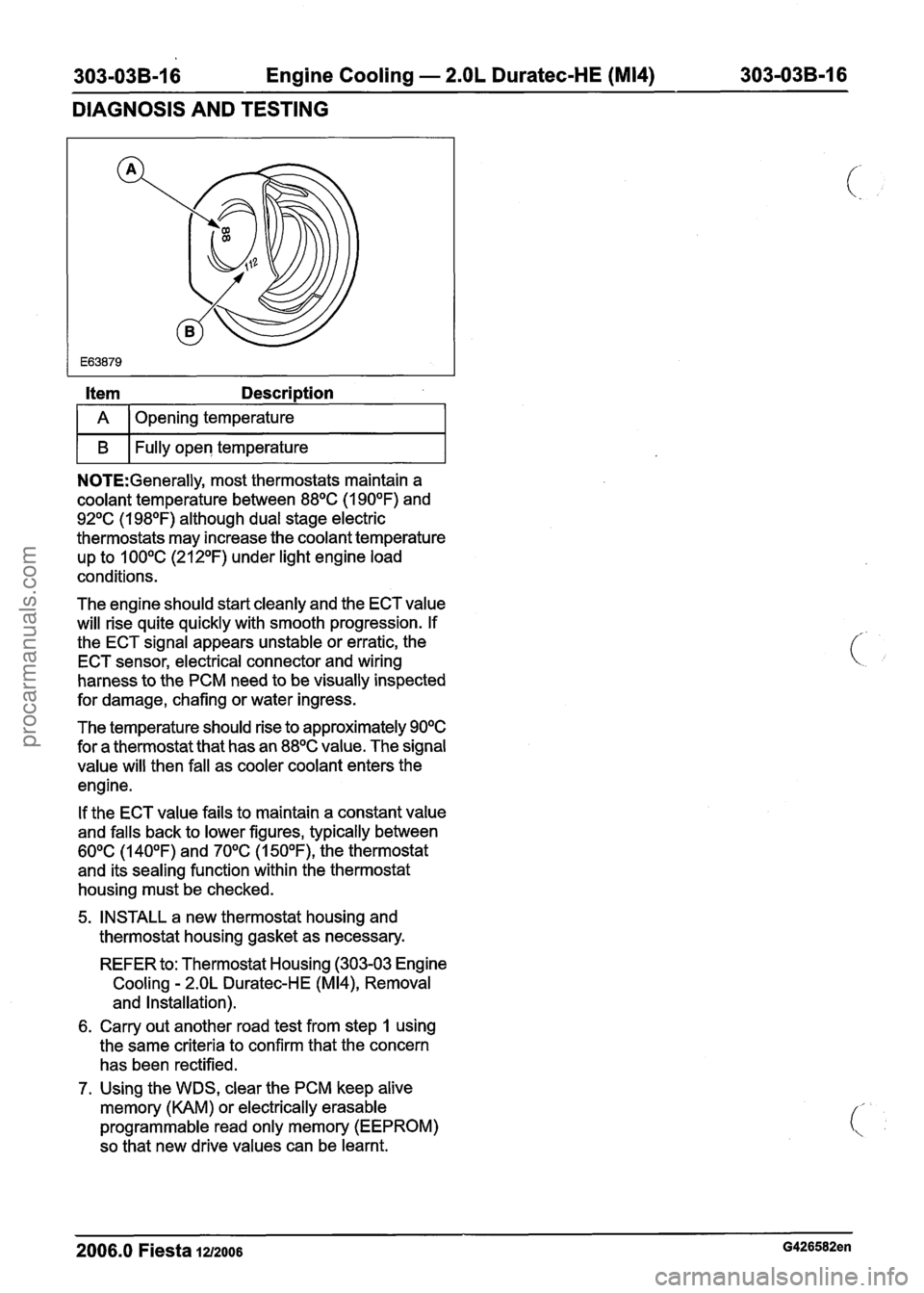
303-03B-16 Engine Cooling - 2.OL Duratec-HE (M14) 303-03B-16
DIAGNOSIS AND TESTING
Item Description
I A 1 Opening temperature I
I B I Fully open temperature I
NOTE:Generally, most thermostats maintain a
coolant temperature between
88OC (1 90°F) and
92OC (1 98OF) although dual stage electric
thermostats may increase the coolant temperature
up to
100°C (212OF) under light engine load
conditions.
The engine should start cleanly and the ECT value
will rise quite quickly with smooth progression. If
the ECT signal appears unstable or erratic, the
ECT sensor, electrical connector and wiring
harness to the PCM need to be visually inspected
for damage, chafing or water ingress.
The temperature should rise to approximately
90°C
for a thermostat that has an 88OC value. The signal
value will then fall as cooler coolant enters the
engine.
If the ECT value fails to maintain a constant value
and falls back to lower figures, typically between
60°C (140°F) and 70°C (1 50°F), the thermostat
and its sealing function within the thermostat
housing must be checked.
5, INSTALL a new thermostat housing and
thermostat housing gasket as necessary.
REFER to: Thermostat Housing (303-03 Engine
Cooling
- 2.OL Duratec-HE (M14), Removal
and Installation).
6. Carry out another road test from step 1 using
the same criteria to confirm that the concern
has been rectified.
7. Using the WDS, clear the PCM keep alive
memory (KAM) or electrically erasable
programmable read only memory (EEPROM)
so that new drive values can be learnt.
2006.0 Fiesta 1212006 G426582en
procarmanuals.com
Page 787 of 1226
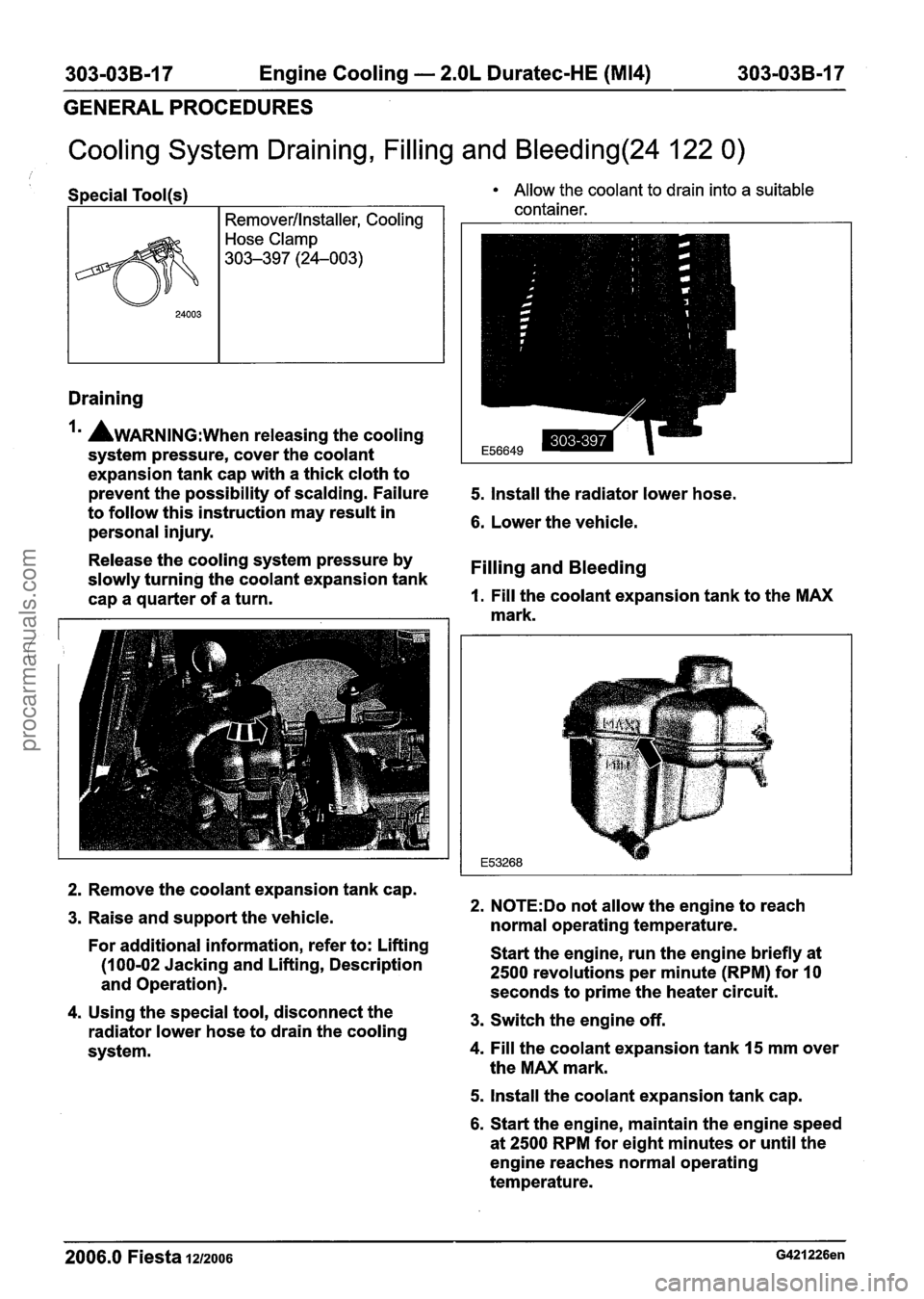
303-03B-17 Engine Cooling - 2.OL Duratec-HE (M14) 303=03B-17 --
GENERAL PROCEDURES
Cooling System Draining, Filling and Bleeding(24 122 0)
Draining
, Special Tool(s) Allow the coolant to drain into a suitable
Im AWARNING:~~~~ releasing the cooling
system pressure, cover the coolant
expansion tank cap with a thick cloth to
prevent the possibility of scalding. Failure
5. Install the radiator lower hose.
to follow this instruction may result in
personal injury.
6. Lower the vehicle.
Release the cooling system pressure by
slowly turning the coolant expansion tank
Filling and Bleeding
cap a quarter of a turn. 1. Fill the coolant expansion tank to the MAX
mark.
container.
24003
2. Remove the coolant expansion tank cap.
3. Raise and support the vehicle.
For additional information, refer to: Lifting
(1 00-02 Jacking and Lifting, Description
and Operation).
4. Using the special tool, disconnect the
radiator lower hose to drain the cooling
system.
Removerllnstaller, Cooling
Hose Clamp
303-397 (24-003)
2. N0TE:Do not allow the engine to reach
normal operating temperature.
Start the engine, run the engine briefly at
2500 revolutions per minute (RPM) for 10
seconds to prime the heater circuit.
3. Switch the engine off.
4. Fill the coolant expansion tank 15 mm over
the MAX mark.
5. Install the coolant expansion tank cap.
6. Start the engine, maintain the engine speed
at
2500 RPM for eight minutes or until the
engine reaches normal operating
temperature.
2006.0 Fiesta 1212006
procarmanuals.com
Page 788 of 1226
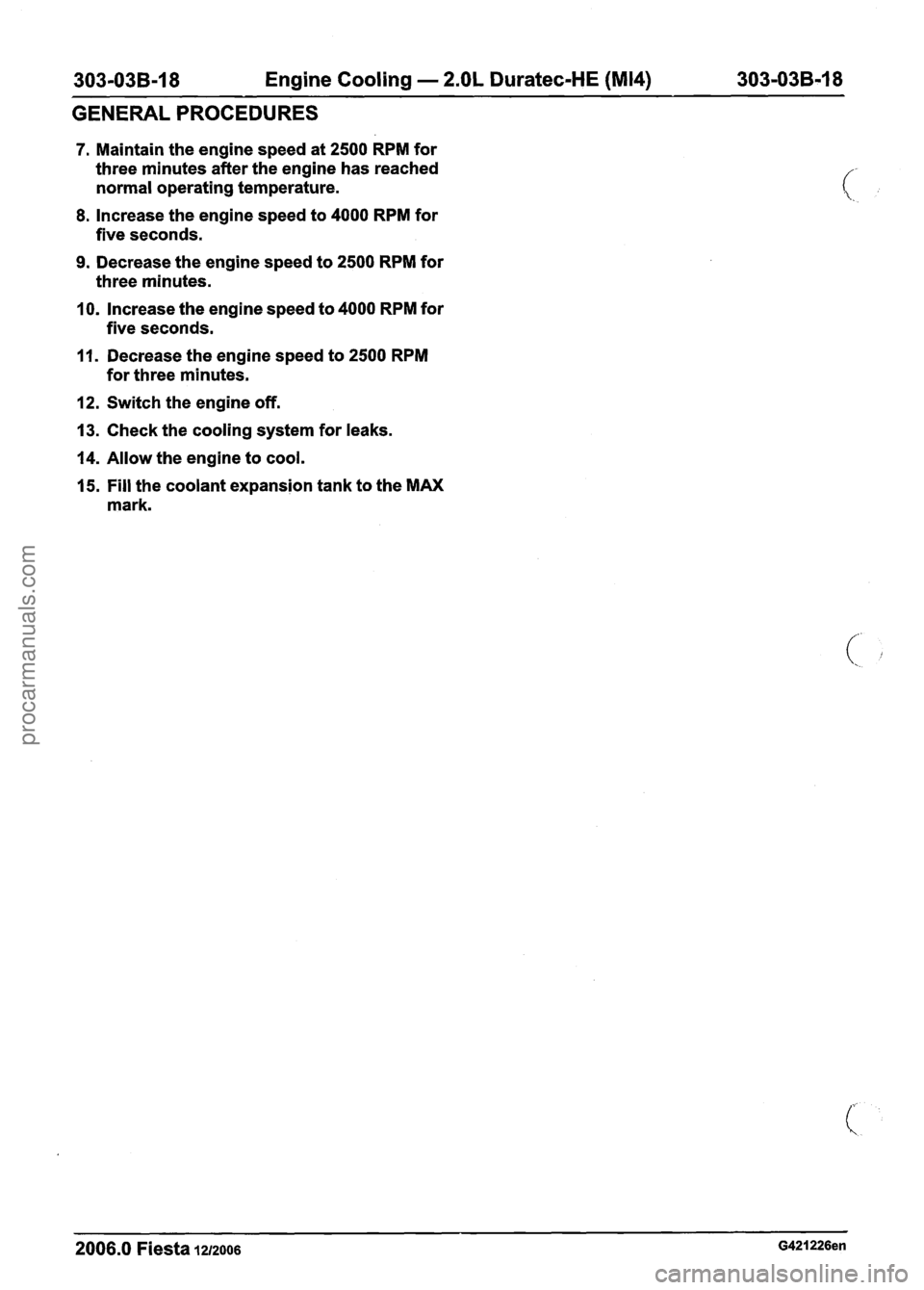
303-038-1 8 Engine Cooling - 2.OL Duratec-HE (M14) 303-03B-18
GENERAL PROCEDURES
7. Maintain the engine speed at 2500 RPM for
three minutes after the engine has reached
normal operating temperature.
8. lncrease the engine speed to 4000 RPM for
five seconds.
9. Decrease the engine speed to 2500 RPM for
three minutes.
10. lncrease the engine speed to 4000 RPM for
five seconds.
11. Decrease the engine speed to 2500 RPM
for three minutes.
12. Switch the engine off.
13. Check the cooling system for leaks.
14. Allow the engine to cool.
15. Fill the coolant expansion tank to the MAX
mark.
2006.0 Fiesta 1212006 G421226en
procarmanuals.com
Page 789 of 1226
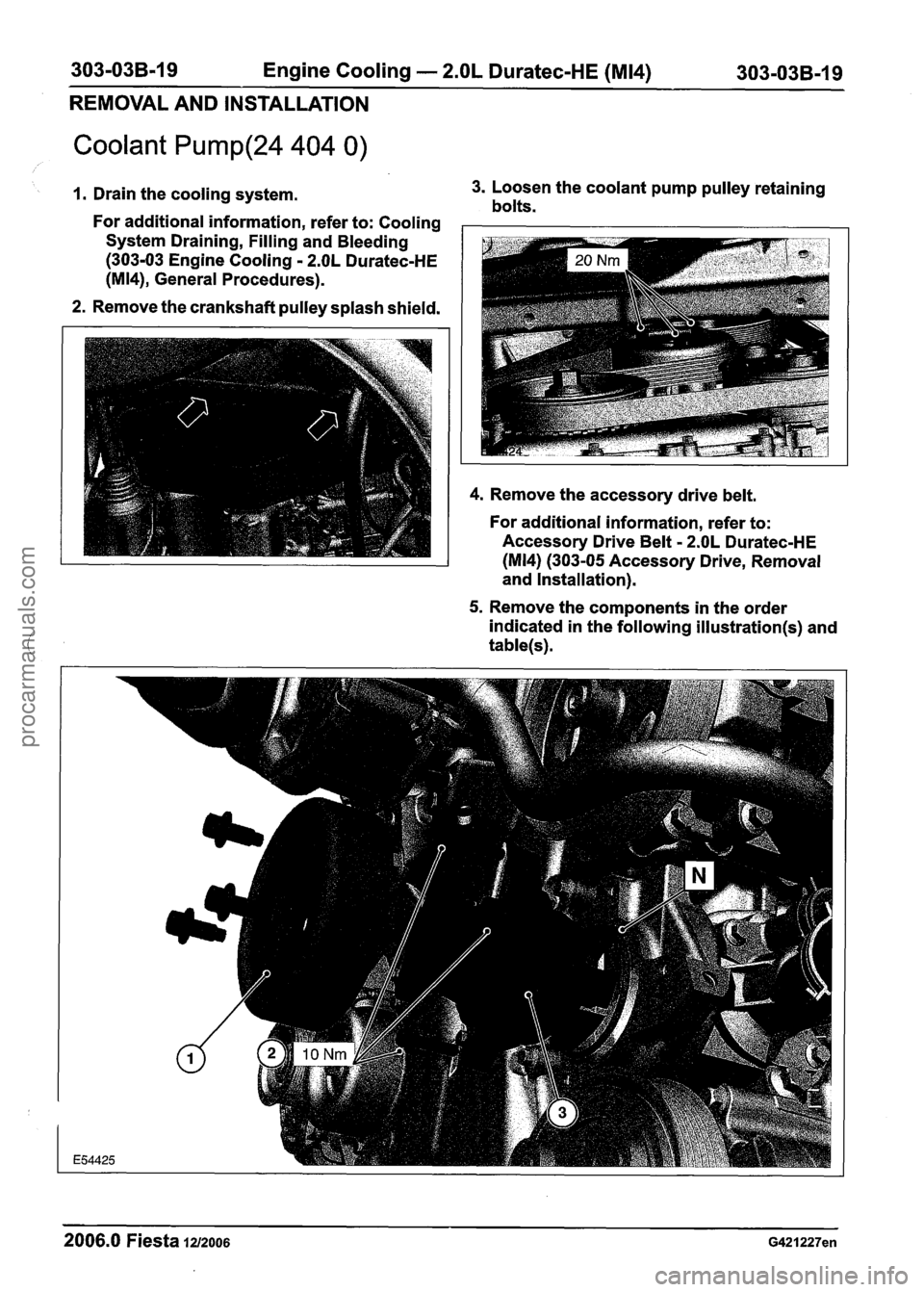
303-03B-19 Engine Cooling - 2.OL Duratec-HE (M14) 303-03B-19
REMOVAL AND INSTALLATION
Coolant Pump(24 404 0)
1. Drain the cooling system. 3.
Loosen the coolant pump pulley retaining bolts. - - - - - - -
For additional information, refer to: Cooling -
System Draining, Filling and Bleeding
(303-03 Engine Cooling - 2.OL Duratec-HE
(M14), General Procedures).
2. Remove the crankshaft pulley splash shield.
4. Remove the accessory drive belt.
For additional information, refer to:
Accessory Drive Belt
- 2.OL Duratec-HE
(M 14) (303-05 Accessory Drive, Removal
and Installation).
5. Remove the components in the order
indicated in the following
illustration(s) and
table(s).
2006.0 Fiesta 1212006 G421227en
procarmanuals.com
Page 790 of 1226
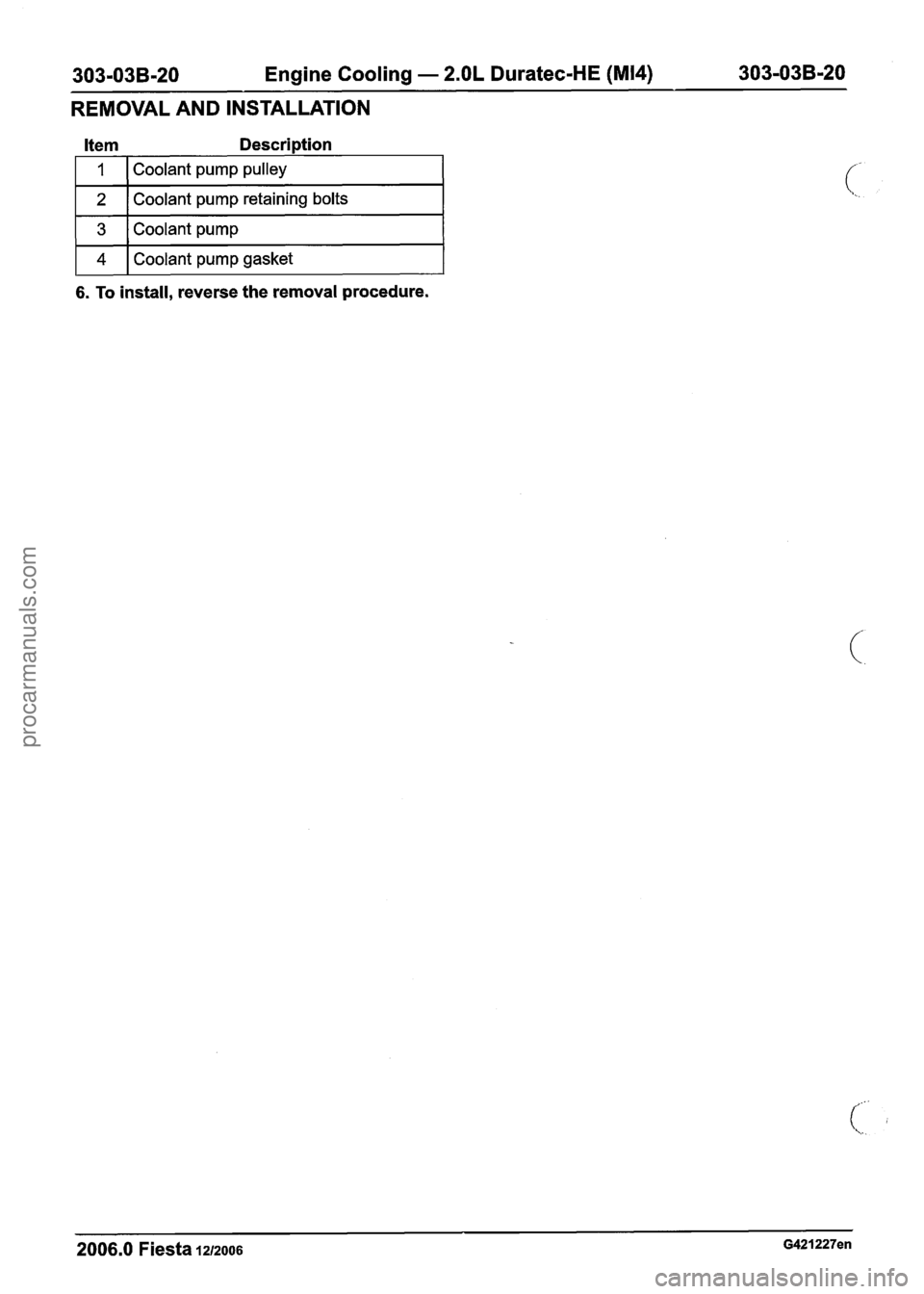
303-03B-20 Engine Cooling - 2.OL Duratec-HE (M14) 303-03B-20
REMOVAL AND INSTALLATION
Item Description
1
2
6. To install, reverse the removal procedure.
Coolant pump pulley
Coolant pump retaining bolts
3
4
2006.0 Fiesta 1u2oos G421227en
- --
Coolant pump
Coolant pump gasket
procarmanuals.com
Page 791 of 1226
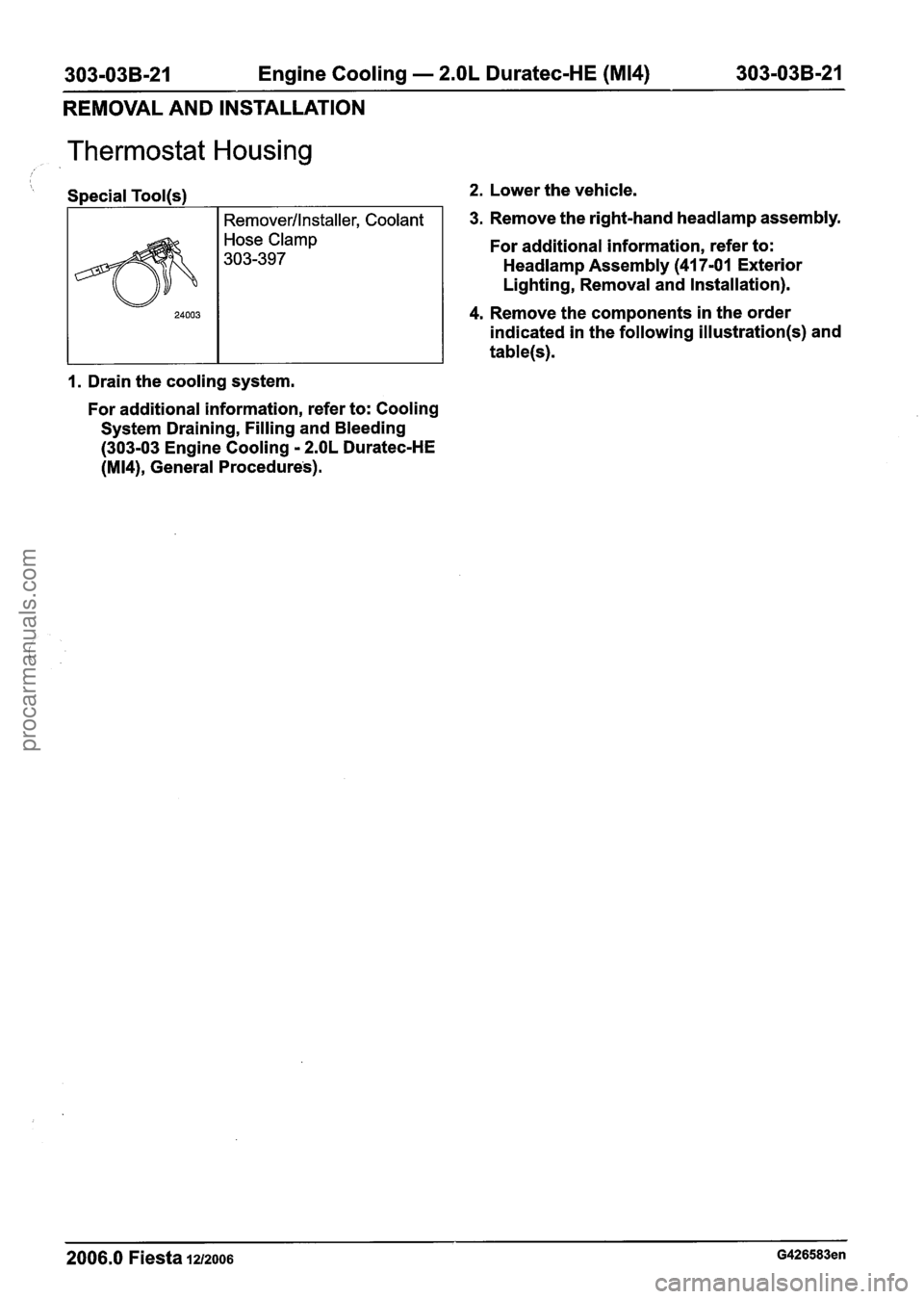
303-03B-21 Engine Cooling - 2.OL Duratec-HE (M14) 303-03B-21
REMOVAL AND INSTALLATION
Thermostat Housing
Special Tool(s) 2. Lower the vehicle.
I Remover/lnstaller, Coolant 1 3. Remove the right-hand headlamp assembly.
1. Drain the cooling system.
I
For additional information, refer to: Cooling
System Draining, Filling and Bleeding
(303-03 Engine Cooling
- 2.OL Duratec-HE
(M14), General Procedures).
Hose Clamp
303-397 For additional information, refer to:
Headlamp Assembly (41 7-01 Exterior
Lighting, Removal and Installation).
4. Remove the components in the order
indicated in the following
illustration(s) and
table(s).
2006.0 Fiesta 1212006 G426583en
procarmanuals.com
Page 792 of 1226
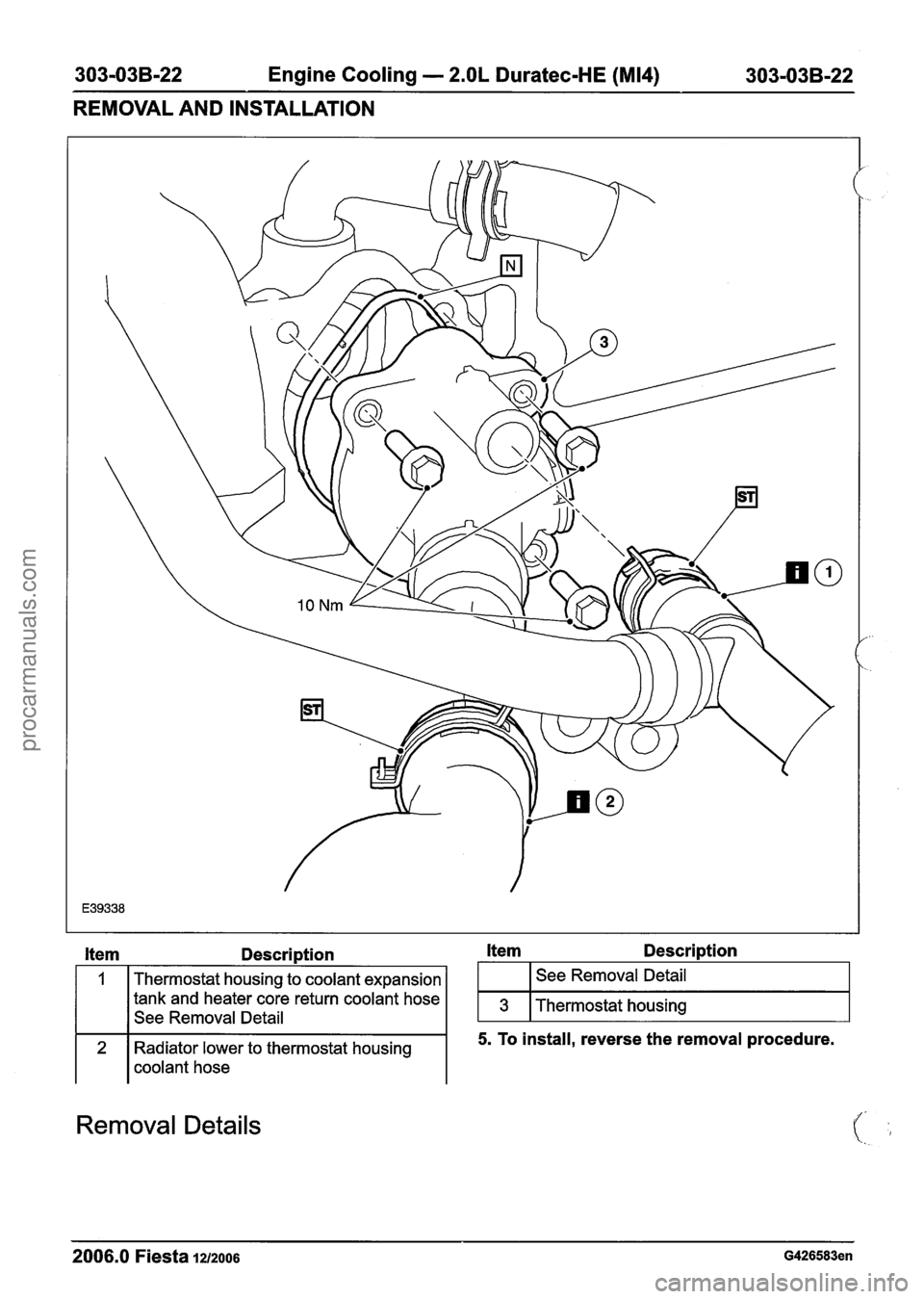
303-03B-22 Engine Cooling - 2.OL Duratec-HE (M14) 303-03B-22
REMOVAL AND INSTALLATION
Item Description Item Description
I 1 coolant hose
Removal Details
2
2006.0 Fiesta 1212006 G426583en
1
3
Thermostat housing to coolant expansion
tank and heater core return coolant hose
See Removal Detail
Radiator lower to thermostat housing See
Removal Detail
Thermostat housing
5. To install, reverse the removal procedure.
procarmanuals.com